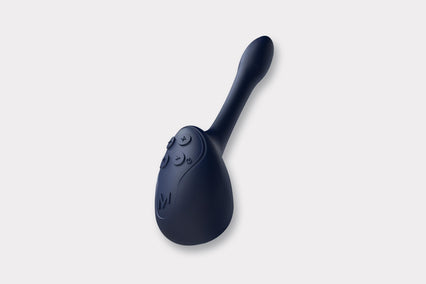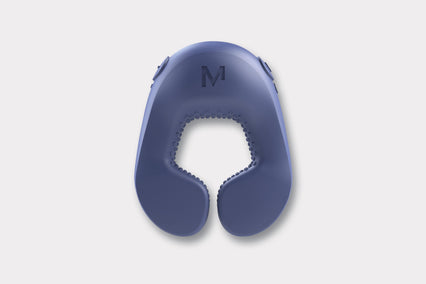Written by: Goh!ddess
If you’ve read our pompoir guide, you were probably taken aback by the versatility of the vaginal muscles.
“Wait… you’re telling me I can twist a penis using only my vagina? No way!”
Yes way. That’s exactly what we’re telling you.
But, before you can start wowing your partner with these vaginal techniques (which are not only impressive, by the way, but extremely pleasurable) you’ll need to develop one key principle in your pelvic floor muscles: strength.
And not just strength - but functional strength.
In this guide, we’re going to cover three beginner-friendly pompoir exercises that will strengthen your pelvic floor muscles, so that you’re able to smoothly transition to more complex moves, such as wringing and locking, including:
Pompoir Exercise #1: The Concentric Contraction
Every strength training exercise can be broken down into three main parts: the concentric contraction, the eccentric contraction, and an isometric hold.
A concentric contraction is what most of us first think of when we think of training a muscle: lifting a dumbbell, pushing a leg press machine with our feet, and extending our arms during a push up.
Training the concentric part of a movement is the most straightforward way to increase strength and power, and learn the correct way to perform an exercise.
When it comes to pompoir, performing concentric contractions will help you rapidly gain some explosive strength, build muscle memory to perform in different situations (I.e. sex positions) and get your blood pumping for a great vaginal workout.

How to Perform Concentric Contractions
Following pelvic floor health principles, it’s important to align your breathing with the different stages of this movement to follow the natural rhythm of the thoracic diaphragm.
- Assume a comfortable position. Ideally sitting down on a chair with your legs closed to start with. As you get familiar with this movement, you can vary your positions.
- Inhale.
-
Exhale and lift your pelvic floor muscles by contracting.
To do this, think of the natural reaction you have when you’re trying to hold in your pee. Pull in as if you are trying to hold the pee inside of you. This should feel like a strong pull up and inwards, as if you were playing tug of war from your inside. - Inhale again as you relax your pelvic floor, letting go of that pull.
- Repeat that same strong pull and sync the movement with your exhalations 20 times.
Practice this entire cycle three times, resting for 2-3 minutes in between those 20 repetitions.
If you’ve never done any Kegel exercises before, it’s natural that this movement will feel a bit uncomfortable at first.
It might seem more intuitive to perform this movement as you inhale, but this would be incorrect, as it only adds unnecessary tension in your pelvic floor.
If you cannot perform 20 repetitions of this concentric contraction, then this could indicate that you need to build up your pelvic floor strength before you can transition into more complex movements.
Don’t worry, the following exercises and tips will help you with that.
To progress with this movement, instead of doing more repetitions at a time, consider focusing on the power of each contraction.
Instead of keeping your contractions close to the entrance of your vaginal canal, attempt to take them deeper inside of you.
And instead of pulling gently, try to be more explosive with the movement, as if your Tug of war team needed one last, final pull to win the battle.
Pompoir Exercise #2: The Eccentric Contraction
Eccentric contractions are the “lowering” part of the movement, when the muscle fibers lengthen versus shorten, returning to their resting state.
Focusing on the eccentric part of the movement (also called “the negative”) places a greater demand on the muscles because it creates resistance that forces the muscle fibers to lengthen under tension. This makes it the most effective strategy for building muscle & strength.
This style of training also lengthens your muscle fibers, increasing their flexibility and decreasing your risk of injury.
However, due to this style of training placing a greater demand on your muscles, these exercises can take a longer time to recover from.
Some examples of eccentric training you might be familiar with include lowering yourself slowly after doing a pull up, slowly bringing the barbell down during a dead-lift, and running downhill.
When it comes to pompoir training, focusing on “negative work” is a great strategy to incorporate once a week to lengthen your muscle fibers, prevent risk of injury, and identify the different levels of your vaginal canal (which is key to perform more motions like sucking, whipping, and locking).

How to Perform Eccentric Contractions
Perform eccentric contractions after your initial cycle of concentric contractions, so that your body is properly warmed up.
- Adopting the same position as before (sitting down on a chair with your legs closed), inhale through your nose.
- Exhale and contract all the way up in one swift motion.
- Inhale again, and this time, focus on slowly relaxing your muscles down, as if you were passing down through different levels of a building inside an elevator, until your muscles are fully relaxed. Control that motion going down from the top of your vaginal canal, all the way to the entrance.
- Repeat steps 2 and 3, 20 times.
Again, repeat this entire cycle three times, taking a few minutes to rest after each one.
By now, your vaginal muscles should be feeling warm, and you might even start to feel a little aroused (or very aroused).
This is the nature of pompoir.
You’re essentially teaching your body how to be more effective at drawing blood to that area and toning the entire pelvic floor, which in turn makes your involuntary vaginal contractions stronger (hence why your orgasms also get stronger when you train pompoir).
Pompoir Exercise #3: The Isometric Contraction
Isometric contractions are a form of exercise that involves the static contraction of a muscle without any movement. During an isometric contraction the force produced by the muscle is equal to its resistance.
Resistance can come from different sources:
- Certain weight placed in a static hold (for example, holding your friends’ box of kitchen appliances when you’re helping her move apartments)
- A still surface (like pushing against a wall)
- Gravity (like the oh-so-familiar pull towards the ground when you’re holding a plank)
So when is it a good idea to use this style of training?
Generally when you want to break through a strength plateau.
The more you advance on your pompoir journey, the more complex the exercises and techniques will become. And the best way to guarantee you’ll be able to perform all of these incredible vaginal techniques is by keeping your muscles strong, flexible, and functional.
So as you continue your training, it’s a great idea to always incorporate some isometrics into your weekly routine.
Holding a movement at the very end of its range of motion increases the time under tension (a key component of strength training), while also improving your coordination and balance.

How to Perform Isometric Contractions
You can either perform this exercise after your cycles of concentric contractions and eccentric contractions, or use it later in your pompoir journey, when you’re already working through more complex techniques and feel like your strength has plateaued.
To perform this exercise:
- Once again, sit down on a chair with your legs closed, and inhale gently through your nose.
- As you exhale, lift your pelvic floor muscles up like before, only this time, hold that contraction.
- Continue breathing in and out normally as you hold that contraction for as long as you can. Aim for 10 seconds.
- After 10 seconds (or as long as you were able to hold for) relax your pelvic floor again as you inhale.
- Wait 1 minute and perform steps 1-4 again. Do this 3 times.
If you don’t have any experience with pelvic floor training, you may not be able to hold this contraction for 10 seconds, at least initially – which is perfectly normal.
And of course, the goal is to slowly ramp up your time under tension (how long you can hold your contraction for).
However, the most important factor here is proper form.
Instead of challenging yourself to hold a weak, shaky contraction for 30 seconds, aim to hold a strong, steady pull for 10 seconds.
After you’ve achieved that for a week or so, see if you can increase the time under tension by 5 more seconds.
Then 5 more over the next few weeks. And so on, until you get to 30 second holds. Holding for longer than 30 seconds is not advisable because you’ll likely start to experience diminishing returns and you may put yourself at risk of injuring your pelvic floor.
Wrap up your pompoir training with 10 to 15 minutes of pelvic floor stretching.
Train Hard, Rest Harder
The rest portion of exercising is just as important as training.
During a workout, you damage your muscles, causing microtears to your muscle fibers that then get repaired and built back stronger during rest.
So make no mistake: relaxing and resting your pelvic floor is just as important as training it to achieve healthy levels of strength and control.
The three main ways to ensure this are:
- Stretching: Aim to spend at least 10 minutes stretching your pelvic floor after you’ve trained. Positions like the happy baby, the yogi squat, the sphinx and child’s pose are all great for this.
- Short rests: Don’t train pompoir every day. A 20-minute workout is recommended, followed by 10 minutes of stretching Monday through Friday, and taking the weekends off. Remember that if you’re doing these moves during sex, you’re also actively working your muscles, so you might want to consider (as sexy as it sounds) stretching after sex.
- Longer rests: Taking one week off from training each month is recommended to rest your muscles. A great opportunity to do so is when you have your period.
You’ll find that you come back feeling a lot stronger the week after your rest when your body has had a chance to repair itself.
Master Pompoir With The Oh!lympus Program
The Oh!lympus Program is a step-by-step online course on Pompoir by Goh!ddess.
This beautifully illustrated training teaches you the art of pompoir in a visual, science-backed way through practical animations, printable guides, and active community.
What you’ll learn:
- How to gain full control over your vaginal muscles in a fun & safe way that naturally increases your libido and pleasure.
- How to master over 27+ combinations of pompoir movements to transform your sexual experience (including squeezing, tilting, sucking, whipping, twisting, and more!).
- How to apply these movements in different sex positions to dramatically increase you and your partner’s pleasure, and watch your relationship transform as a result.
Save $100 off the Oh!lympus program by signing up via MysteryVibe's link.















































